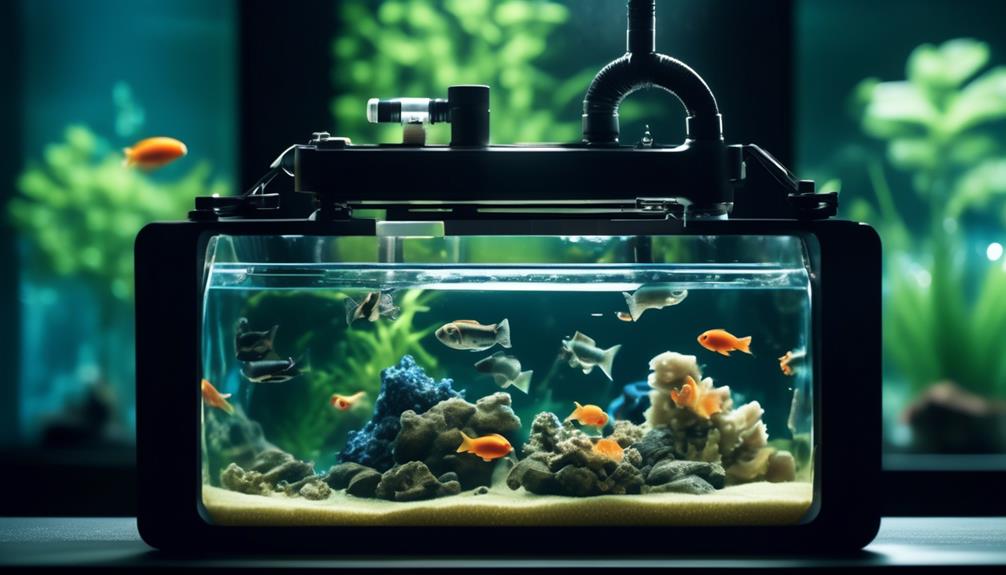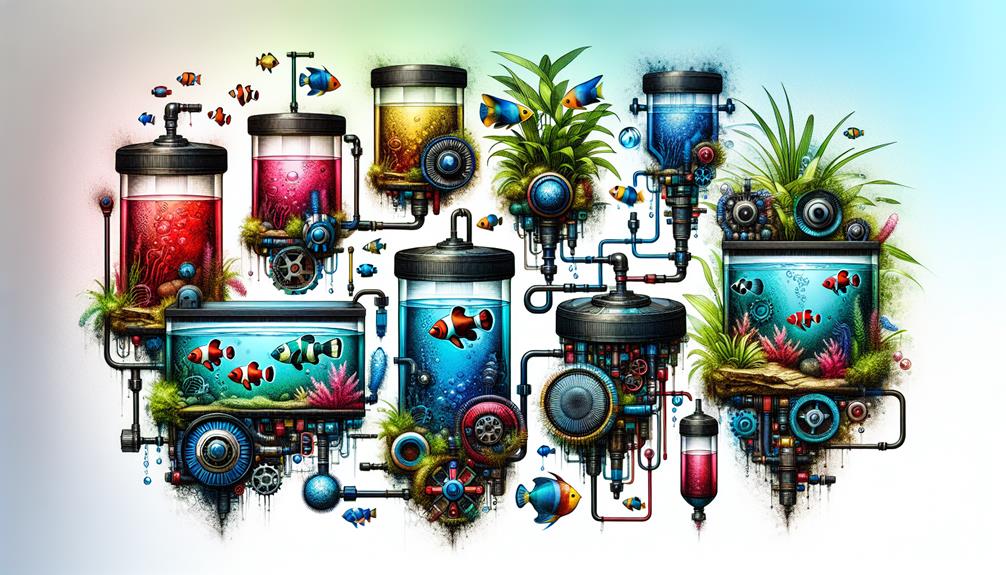When it comes to maintaining a healthy and thriving aquarium, choosing the right fish tank filter is paramount. A well-designed filter is not only essential for removing impurities and maintaining water quality, but it also contributes to the overall well-being of your aquatic inhabitants.
However, with the multitude of options available in the market, finding the perfect filter can be a daunting task. In this article, we will take a closer look at the various types of fish tank filters and their respective benefits and drawbacks.
We will also explore the role of live aquarium plants in enhancing filtration and provide valuable tips to help you make an informed decision. So, if you're looking to optimize your aquarium's filtration system, stay tuned for some expert advice.
Key Takeaways
- Proper aquarium filtration is essential for maintaining a safe and clean environment for fish.
- There are three types of filtration: mechanical, biological, and chemical, each serving a specific purpose in keeping the water clear and safe.
- Different types of filters, such as sponge filters, hang-on-back filters, and canister filters, offer varying levels of effectiveness and customization.
- Live aquarium plants provide excellent biological filtration and offer additional benefits such as reducing the need for water changes and providing shelter for fish. However, they do not provide mechanical or chemical filtration and require regular maintenance.
Importance of Filtration in Aquariums
Filtration plays a vital role in maintaining a healthy and thriving aquarium ecosystem. It is crucial to understand the advantages of biological filtration and choosing the right filter media.
Biological filtration utilizes beneficial bacteria to break down toxic waste, ensuring the overall health and well-being of aquarium inhabitants. These bacteria convert ammonia into nitrite and then into nitrate, which is less harmful to fish.
Choosing the right filter media is essential for effective biological filtration. Porous materials such as ceramic rings, bio balls, or sponges provide a large surface area for the bacteria to colonize. These materials also allow for proper water flow, ensuring efficient filtration.
It is important to consider the needs of your aquarium and research different filter media options to find the one that suits your specific requirements.
Types of Filtration for Fish Tank
Aquarium filtration is a fundamental component of maintaining optimal water quality and ensuring the health and well-being of fish and other aquatic inhabitants. There are different types of filtration that serve specific purposes in maintaining the aquarium ecosystem.
| Type of Filtration | Description |
|---|---|
| Mechanical Filtration | Removes debris and physical impurities from the water using sponges, filter socks, and filter floss pads. |
| Biological Filtration | Utilizes beneficial bacteria or aquarium plants to break down toxic waste and create a safe environment for fish. |
| Chemical Filtration | Removes impurities and contaminants from the water using activated carbon or special resins. |
Each type of filtration offers unique benefits. Biological filtration ensures the breakdown of toxic waste, promoting a healthier environment. Chemical filtration removes impurities, improving water quality. Mechanical filtration makes water clearer by removing debris. Different filters excel in specific types of filtration. Understanding the benefits of each type will help in selecting the right filter for your fish tank.
Pros and Cons of Different Filter Options

When considering the various options for fish tank filters, it is important to weigh the advantages and disadvantages of each choice.
Sponge filters have several pros, including being cost-effective and reliable. They consist of a sponge filter, air pump, and airline tubing, providing good water circulation and surface agitation. They are easy to clean and maintain, making them popular in fish stores, fish rooms, and breeding facilities.
On the other hand, canister filters offer advantages such as being highly customizable and powerful. They take up little space inside the aquarium and provide excellent filtration for demanding setups. However, they require disassembly for maintenance and have a higher price tag.
Benefits of Live Aquarium Plants
Live aquarium plants offer a multitude of benefits for the overall health and well-being of aquatic ecosystems. Here are some of the key advantages of incorporating live plants into your aquarium:
- Biological Filtration: Live plants absorb ammonia and nitrogen compounds from the soil, which are produced by fish and organic waste in the aquarium. This helps to reduce the levels of these harmful substances and maintain water quality.
- Reduced Water Changes: By absorbing these waste compounds, live plants help to minimize the need for frequent water changes. This not only saves time and effort but also ensures a more stable and balanced environment for your fish.
- Shelter for Fish: Live plants provide shelter and hiding places for shy or small fish, reducing stress and promoting natural behavior.
- Oxygen Production and Algae Control: Through photosynthesis, live plants produce oxygen, enhancing the oxygen levels in the aquarium for the benefit of the fish. Additionally, by utilizing nutrients in the water column, live plants help to reduce the availability of these nutrients for algae growth.
To care for live aquarium plants, ensure they receive adequate lighting, provide them with a suitable substrate or fertilizer, and regularly trim and maintain them to prevent overgrowth and maintain a healthy ecosystem.
Tips for Choosing the Right Fish Tank Filter

Tips for Choosing the Right Fish Tank Filter
In the realm of aquarium maintenance, the selection of an appropriate fish tank filter is a crucial consideration for maintaining optimal water quality and ensuring the well-being of aquatic inhabitants. When choosing a fish tank filter, there are several factors to consider.
| Factor | Description |
|---|---|
| Maintenance | Consider the ease of maintenance and cleaning. Some filters may require frequent cleaning or replacement of filter media. |
| Filtration Type | Determine the type of filtration needed for your aquarium. Mechanical, biological, and chemical filtration each serve specific purposes. |
| Tank Size | Consider the size of your aquarium. Larger tanks may require more powerful filters or multiple filters to effectively circulate and filter the water. |
| Noise Level | Evaluate the noise level of the filter. Quiet operation is desirable, especially for aquariums located in living spaces. |
| Budget | Take into account your budget. Different filters come at varying price points, and it's essential to find one that meets your needs without breaking the bank. |
Frequently Asked Questions
What Is the Recommended Frequency for Cleaning and Maintaining a Sponge Filter?
The recommended frequency for cleaning and maintaining a sponge filter depends on the specific aquarium conditions and the amount of debris accumulated. Regular monitoring and cleaning of the sponge filter is necessary to ensure optimal performance and water quality.
Can Hang-On-Back Filters Be Used in Saltwater Aquariums?
Can hang-on-back filters be used in saltwater aquariums? Hang-on-back filters are versatile and can be used in both saltwater and freshwater aquariums. They offer customizable filter media and provide effective mechanical filtration for saltwater tanks.
Are Canister Filters Suitable for Small or Nano Aquariums?
Canister filters are generally not suitable for small or nano aquariums due to their size and maintenance requirements. Sponge filters, on the other hand, are a popular choice for nano aquariums as they provide good water circulation and are easy to clean and maintain.
Which Types of Live Aquarium Plants Are Best for Beginners?
The best plants for low light aquariums are Anubias, Java Fern, and Java Moss. These plants are hardy, easy to propagate, and require minimal lighting. To propagate aquarium plants effectively, simply cut and replant healthy portions of the plant.
How Often Should the Filter Media Be Replaced in a Fish Tank Filter?
The frequency of fish tank filter media replacement depends on the type of media used and the specific aquarium conditions. Signs of a clogged filter include reduced water flow and decreased filtration efficiency. Regular monitoring and maintenance are crucial for optimal filter performance.
Conclusion
In conclusion, selecting the right fish tank filter is essential for maintaining a clean and safe environment for your aquatic companions. Various types of filtration systems, such as sponge filters, hang-on-back filters, and canister filters, offer different benefits and drawbacks.
Additionally, live aquarium plants can contribute to biological filtration. By considering the specific needs of your aquarium and the factors discussed in this article, you can make an informed decision and ensure the optimal health and wellbeing of your fish.

